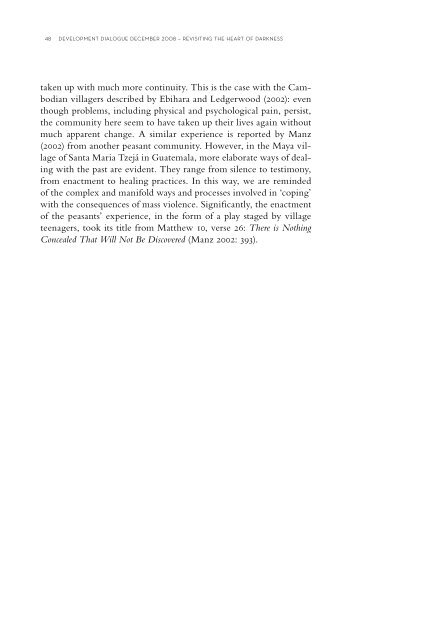48 development dialogue december 2008 – revisiting <strong>the</strong> heart of darkness taken up with much more continuity. This is <strong>the</strong> case with <strong>the</strong> Cambodian villagers described by Ebihara and Ledgerwood (2002): even though problems, including physical and psychological pain, persist, <strong>the</strong> community here seem to have taken up <strong>the</strong>ir lives again without much apparent change. A similar experience is reported by Manz (2002) from ano<strong>the</strong>r peasant community. However, in <strong>the</strong> Maya village of Santa Maria Tzejá in Guatemala, more elaborate ways of dealing with <strong>the</strong> past are evident. They range from silence to testimony, from enactment to healing practices. In this way, we are reminded of <strong>the</strong> complex and manifold ways and processes involved in ‘coping’ with <strong>the</strong> consequences of mass violence. Signifi cantly, <strong>the</strong> enactment of <strong>the</strong> peasants’ experience, in <strong>the</strong> form of a play staged by village teenagers, took its title from Mat<strong>the</strong>w 10, verse 26: There is Nothing Concealed That Will Not Be Discovered (Manz 2002: 393).
Literature Abbink, John (2000), ‘Preface: Violation and Violence as Cultural Phenomena’, in Ajimer and Abbink, pp. xi-xvii. Ajimer, Göran (2000), ‘Introduction: The Idiom of Violence in Imagery and Discourse’, in Ajimer and Abbink, pp. 1-21. Ajimer, Göran and Abbink, Jon (eds) (2000), Meanings of Violence. A Cross Cultural Perspective, Oxford and New York: Berg. Baker, Bruce (2008), Multi-Choice Policing in Africa, Uppsala: Nordiska Afrikainstitutet. Bartov, Omer 1998, ‘Defi ning Enemies, Making Victims: Germans, Jews, and <strong>the</strong> Holocaust’, American Historical Review, vol. 103, pp. 771-816. Bataille, Georges (1989), The tears of Eros, San Francisco: City Lights. Bauman, Zygmunt (1991), Modernity and Ambivalence, Oxford: Polity. Benjamin, Walter (1980), ‘Zur Kritik der Gewalt’, in Benjamin, Walter, Gesammelte Schriften (werkausgabe), vol. II, no. 1, Frankfurt am Main: Suhrkamp, pp. 179-203. Brieskorn, Norbert S. J. (2005), ‘Grausamkeit – Gewalt – Macht’, in Müller and Kiefer, pp. 71-107. Browning, Christopher R. (1992), Ordinary men: Reserve Police Battalion 101 and <strong>the</strong> fi nal solution in Poland, New York: HarperCollins. Brubaker, Rogers (2004), ‘Ethnicity without Groups’, in Wimmer, Andreas, Goldstone, Richard J., Horowitz, Donald L., Joras, Ulrike and Schetter, Conrad (eds), Facing Ethnic Confl icts, Lanham and Oxford: Rowman & Littlefi eld, pp. 34-52. Castells, Manuel (2001), The Internet Galaxy. Refl ections on <strong>the</strong> Internet, Business, and Society, Oxford: Oxford University Press. Chaumont, Jean Michel (2001), Die Konkurrenz der Opfer. Genozid, Identität und Anerkennung, Lüneburg: zu Klampen! (Originally published as La concurrence des victimes, 1997.) Ebihara, May and Ledgerwood, Judy (2002), ‘Aftermaths of Genocide. Cambodian Villagers’, in Hinton, 2002, pp. 272-91. violence, legitimacy and dynamics of genocide – notions of mass violence examined 49 Elias, Norbert ([1937] 1982), Über den Prozess der Zivilisation. Soziogenetische und psychogenetische Untersuchungen (2 vols), Frankfurt am Main: Suhrkamp. Elias, Norbert (1992), Studien über die Deutschen. Machtkämpfe und Habitusentwicklung im 19. und 20. Jahrhnudert, Frankfurt am Main: Suhrkamp. Elwert, Georg (1999), ‘Markets of Violence’, in Elwert et al., pp. 85-102. Elwert, Georg, Feuchtwang, Stephan and Neubert, Dieter (eds), Dynamics of Violence. Processes of Escalation and De-Escalation in Violent Group Confl ic t s, Berlin: Duncker & Humblot (Sociologus Supplement 1). Foster, Don Paul Haupt and de Beer, Marésa (2005), The Theatre of Violence. Narratives of Protagonists in <strong>the</strong> South African Confl ict, Oxford: James Currey/ Cape Town: HSRC Press. Galtung, Johan (1975a), ‘Violence, Peace, and Peace Research’, in Galtung, Johan, Peace: Research – Education – Action. Essays in Peace research, vol. I, Copenhagen: Christian Ejlers, pp.109-134. Galtung, Johan (1975b), ‘Structural and Direct Violence. A Note on Operationalization’, in Galtung, Johan, Peace: Research – Education – Action. Essays in Peace research, vol. I, Copenhagen: Christian Ejlers, pp. 135-139 Gellately, Robert and Kiernan, Ben (2003), ‘The Study of Mass Murder and Genocide’, in Gellately, Robert and Kiernan, Ben, pp. 3-26. Gellately, Robert and Kierrnan, Ben (eds) (2003), The Specter of Genocide. Mass Murder in Historical Perspective, Cambridge: Cambridge University Press. Gerstenberger, Heide (2006), Die subjektlose Gewalt. Theorie der Entstehung bürgerlicher Staatsgewalt, 2nd ed., Münster: Westfälisches Dampfboot. Gewald, Jan-Bart (1999), Herero heroes: A sociopolitical history of <strong>the</strong> Herero of Namibia 1890-1923, Oxford: James Currey / Cape Town : David Philip / A<strong>the</strong>ns, Ohio: Ohio University Press. Hauck, Gerhard (2004), ‘Schwache Staaten? Überlegungen zu einer fragwürdigen entwicklungspolitischen Kategorie’, in Peripherie, no. 96, pp. 411-27.

















